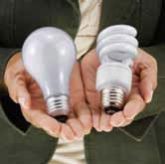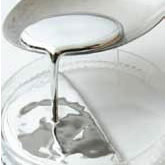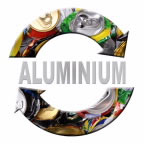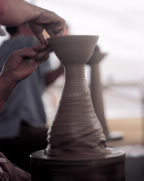Open for Discussion: Lighten Up!
By Barbara Sitzman and Regis Goode
- Download article
- Teacher’s Guide: Word | PDF

Regis: Hi, Barbara. Are you using the new light bulbs? Fluorescent tubes have been shrunk into white spiral bulbs called compact fluorescent lights (CFLs). They use less energy!
Barbara: Well, I just bought a fuel-efficient car. Should I change my light bulbs also? Can I make a difference by changing a single light bulb?
Regis: Actually, it is estimated that exchanging one incandescent bulb for a CFL will save you $105 over the lifetime of the CFL because they last 10 times as long!
Barbara: Ordinary light bulbs, developed by Thomas Edison, have been used for more than 100 years. In these light bulb, electrical energy simply runs through a tungsten filament where it is converted to heat energy. As the filament heats to 2,000 oC, the tungsten atoms gradually vaporize, causing the filament to break and the bulb to “burn out.” Also, these light bulbs are cheap.
Regis: CFLs produce light by a completely different process. Most of the electrical energy is transformed into light rather than heat energy. CFLs contain argon, a nonreactive noble gas, and a drop of mercury (Hg). When you turn on the electricity, electrons excite the Hg atoms. As these atoms return to lower energy states, they release the absorbed energy as ultraviolet (UV) light. CFLs are coated with phosphor, a compound that absorbs UV light and then emits light of a longer wavelength—in this case, in the visible light range.

Barbara: Mercury is a relatively nonreactive liquid at room temperature, and it easily vaporizes. Through a complex environmental cycle, not yet fully understood by scientists, aquatic bacteria transform atomic Hg into highly toxic ions such as methyl mercury (CH3Hg+). With a nonpolar methyl group (–CH3), CH3Hg+ is fat-soluble. When ingested by fish, it is stored in their muscles and moves up the food chain. In addition to impairing the liver, kidneys, and immune system, Hg can cross the blood-brain protective barrier, causing damage to brain cells.
Regis: As long as CFL bulbs are intact, there is no Hg exposure. The actual amount of Hg in new CFLs is only 3–5 mg, the size of a ballpoint pen tip. Some environmentally friendly bulbs contain as little as 1 mg.
Barbara: What should I do if a CFL breaks? I know that Hg is not radioactive, but it is volatile.
Regis: Proper cleanup for Hg spills is always essential. The U.S. Environmental Protection Agency (EPA) recommends airing the room and using sticky tape to collect small pieces. Then, place this material in a sealable plastic bag and call 1-800-CLEAN-UP for the nearest disposal center.
Barbara: CFLs are very expensive, and they may further endanger our environment. How can I justify their purchase?
Regis: Although CFLs cost more than incandescent bulbs, they last 10 times longer, thus saving electricity and reducing the hidden environmental costs related to producing electricity by burning coal.
Mercury, a trace impurity in coal, is released into the atmosphere along with carbon dioxide—a greenhouse gas—during combustion. In fact, one of the largest sources of atmospheric Hg is coal-fired power plants. Even though there is Hg inside CFLs, we potentially reduce the Hg released into the environment.
According to the EPA, if every home converted one bulb to a CFL, we would save enough energy every year to light 3 million homes and prevent greenhouse gas emissions equivalent to those from 800,000 cars. What a great way to help reduce our dependence on fossil fuels!
| 25-Watt CFL* | 100-Watt Incandescent | |
| Lamp Cost | $3.40 | $0.60 |
| Lamp Life | 1,667 days | 167 days |
| Annual Energy Cost | $6 | $25 |
| Emission of Hg | 1.8 mg** | 5.8 mg (power plant) |
Source: Life Cycle Cost Estimate for ENERGY STAR-Qualified Compact Fluorescent Lamp(s) *A 25-watt CFL emits the same amount of visible light as a 100-watt incandescent | ||
Barbara: I wonder about the light from CFLs. The color doesn’t appear to truly match sunlight.
Regis: Initially, that was true. But engineers have designed new CFLs with a variety of phosphors to create a warmer glow in a range of colors and shades that you can use to set the right mood in your room. Even yellow outdoor “bug lights” are available.
Barbara: It sounds like I can make a difference. Switching to more energy-efficient light bulbs not only reduces environmental pollution but saves money, as well. One person and one bulb change can make a difference!
Regis: You have several choices to light your home. Incandescent light bulbs and CFLs are just two of these. Which type of bulb would you choose? Send us your thoughts to: chemmatters@acs.org.
Also in the April 2012 issue...

Recycling Aluminum: A Way of Life of a Lifestyle?
In the Western world, recycling aluminum helps to protect the environment. In India, it is a means of livelihood for thousands of people. Learn how recycling aluminum is changing lives and helping the environment.

Artist Studio Tour: Chemistry on a Country Road
When you create Raku pottery or make a piece of stained glass, not only are you having fun, but you are also doing chemistry.


